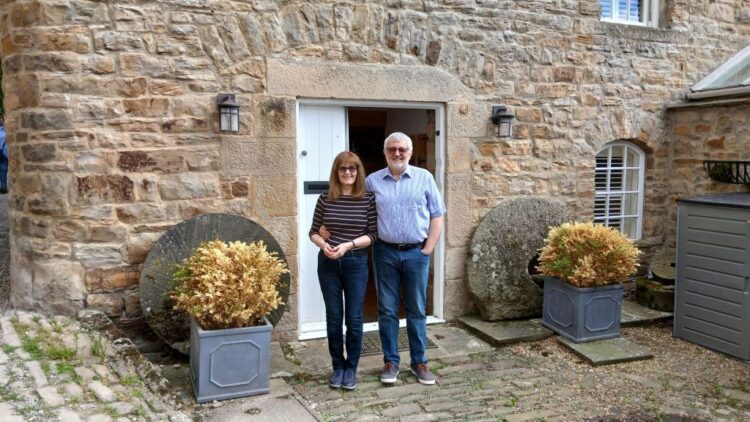A two-year quest has concluded as a converteda 13th century Teesdale mill receives a prestigious blue plaque.
Demesnes Mill sits on the banks of the River Tees in a site it has occupied in Barnard Castle since the 1200s, when Hugh Baliol, a descendant of the castle’s founder Guy de Baliol, decreed that the town’s occupants had to use the watermill to grind their corn.
It was built at a time when Henry III – son of the infamous King John – occupied the throne and the Scots would frequently raid northern England.
Fast forward almost 800 years and a mill still exists on the same site – albeit one that is now a tastefully restored home with spectacular views of the river owned since 2018 by Alan and Polly Morton.
The bid to have the Grade II-listed property recognised for its historical importance was undertaken by local historian and author Kay Wilson. She spent two years compiling a file of evidence to support her case.
She initially approached Barnard Castle Town Council in May 2022 to request blue plaque status for Demesnes Mill, and it was agreed a request to that effect would be made to Durham County Council.
The county council rejected the bid, so the town council decided to explore installing its own blue plaque with Kay providing proof of Demesnes Mill’s antiquity.
“I’ve always known that the mill was very old,” she told the Mercury. “So I went to the town council to present my case that it should be recognised.
“The council, including the clerk Martin Clark and Mrs Chatterjee, who was then the mayor, were all for it. They said if I could take them some evidence, as much as I could gather, they would look at it.”
Kay tirelessly worked to ensure her case for recognition for the mill was watertight.
She said the book Barnard Castle: Historic Market Town, written by the late Alan Wilkinson in the 1990s, was a vital resource.
Mr Wilkinson, who was a master at Barnard Castle School and a widely-respected historian, had unearthed an ancient town charter stating the mill was established by Hugh Baliol in the 13th century.
Other archival evidence included information on the mill’s workings, some of which are still in place in the building’s basement.
The Fitzhugh Library, in Middleton-in-Teesdale, also unearthed a town charter, which was another piece of crucial evidence proving the mill’s age and importance.
Kay, a former librarian, was grateful to many people who proved helpful to her quest, not least the staff at her former workplace, Barnard Castle Library.
She added: “I put together a big folder of evidence to take back to the council and, happily, they let me know that it did have historical value and it dated from the 13th century.”
All that remained was for the town council to receive planning permission from the county council for the blue plaque to be installed and that was duly granted.
The cost of the plaque – £480 – was covered by the town council and by Kay, who donated proceeds from the sale of her book Barnard Castle: Waterfalls, Weirs and Woodland Streams.
“It’s been wonderful, I’ve enjoyed every minute,” she said. “It’s taken two years and I can’t wait to see the plaque unveiled.”
Remarkably, the mill was in use until 1934, surviving several major floods, including one in 1771 which washed away the wheel located on the outside of the building.
Current occupants Alan and Polly Morton were quick to praise the previous owners Bob and Joan Young, who converted what was a ruined mill into a home in the late 1980s and early 1990s.
“They did a superb job,” said Alan. “It was used as a farm building and was in a pretty ramshackle state and they did the major conversion.
“They stayed until 2013 and the mill had been on the market for four years when we spotted it online in late 2017.
“We signed the papers in the summer of 2018 and spent a couple of years putting our own stamp on the building before moving in in the July of 2020.”
“It’s an absolute dream,” added Polly. “We couldn’t have drawn a picture of a more perfect place for us to live.”




